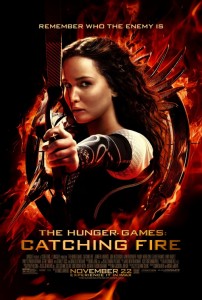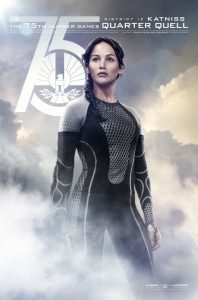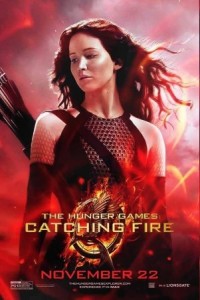 It’s tough to call whether it’s the improvements in the material or the filmmaking that make Catching Fire so much better than The Hunger Games. Francis Lawrence brings a more focused eye to the franchise, certainly, but I suppose it’s all right there in the title- lighting a match is more interesting than simply shaking the matchbox. Granted, this is a modest achievement if you feel, as I do, that the first film was an sloppy, derivative snooze-fest with little to offer other than Jennifer Lawrence’s quiet charisma. However, with a great Lawrence both behind and in front of the camera and a slightly heavier plot to churn through, Catching Fire upgrades the franchise to something resembling “good.”
It’s tough to call whether it’s the improvements in the material or the filmmaking that make Catching Fire so much better than The Hunger Games. Francis Lawrence brings a more focused eye to the franchise, certainly, but I suppose it’s all right there in the title- lighting a match is more interesting than simply shaking the matchbox. Granted, this is a modest achievement if you feel, as I do, that the first film was an sloppy, derivative snooze-fest with little to offer other than Jennifer Lawrence’s quiet charisma. However, with a great Lawrence both behind and in front of the camera and a slightly heavier plot to churn through, Catching Fire upgrades the franchise to something resembling “good.”
Not unlike the first Matrix sequel, the core of The Hunger Games: Catching Fire is a revolutionary figurehead struggling with her own inability to actually do much. It’s a an interesting, layered idea for a young adult series to tackle. This is a series that has also sneaked a revolutionary yarn that hyperbolizes contemporary American class disparity by many of the same people that sneered at Occupy protestors, so there’s that. These are themes Suzanne Collins ended up juggling when she took her high-concept, (inadvertent?) Battle Royale rip-off and went in the direction of an ongoing saga, rather than one-off satire. But the revolutionary who has upended the system finding themselves suddenly inert is a tough story to make dramatic on film, and thus Catching Fire suffers just as Reloaded did right from the word “go.”
The film begins with a lethargic “morning after” feeling, all the momentum and energy let out of the balloon. It’s to Jennifer Lawrence’s credit that the first act of the film is reasonably compelling, as it is largely comprised of Katniss being told how things are, but rarely shown. Through her victory tour we see small bits of the unrest apparently brewing in Panem but, again, we’re following a protagonist that is being deliberately sheltered from the events of the world. That leaves us only with the frustration Katniss feels, and the fear she harbors for her family. It’s thirty minutes of watching our hero pace back and forth while we’re told a noose is tightening around her neck. Panem is a cartoonishly broad dystopia, and we  are given little beyond the basic idea that people are starving in most districts, while the elite purge simply so they can eat more. The symbolic nature of the Hunger Games only means something because we’re told it does, and powerful men talk about “fear” and “hope” as if they’re gases they’re going to pump into the population. We’re told what that narrative is going to be, and we assume a complex sociological order and economic system will react as expected in the vague amounts of time we’re shown. Katniss also has a strange relationship with the capital rulers, as she’s essentially their puppet, and yet free to do things like make trouble for local enforcers (including Romulus Thread, the laughably arch new villain in District 12).
are given little beyond the basic idea that people are starving in most districts, while the elite purge simply so they can eat more. The symbolic nature of the Hunger Games only means something because we’re told it does, and powerful men talk about “fear” and “hope” as if they’re gases they’re going to pump into the population. We’re told what that narrative is going to be, and we assume a complex sociological order and economic system will react as expected in the vague amounts of time we’re shown. Katniss also has a strange relationship with the capital rulers, as she’s essentially their puppet, and yet free to do things like make trouble for local enforcers (including Romulus Thread, the laughably arch new villain in District 12).
Once the movie gets to its real purpose –essentially doing the Hunger Games all over again– it gets roaring with actual characters to introduce and things to do. The silliness of the core premise rears its head in the training sections, but Lawrence nails some great beats between new and old characters- I was surprisingly moved by a gesture from Elizabeth Bank’s Effie, for example. It’s within the arena that the filmmaking improvements really show though, as most every sequence of danger and peril during the Quarter Quell –which pits previous winners of the games against each other, theoretically raising the stakes– is effective and exhilarating. A sequence in which the characters are running away from poisonous gas feels dangerous and gets legitimately ugly, dues ex aqua aside. The more structured nature of this particular arena — still basically a bunch of trees like last time– ends up doing the setpieces justice, as does Lawrence’s decision to entirely ignore the broadcast aspect. We see the arena and the control room, skipping reaction shots of the masses. Even if it further distances us from any sense of greater Panem, it more than makes up for it by tightening things up for Katniss and co.
 Eventually the film must start moving towards the business of setting up two more films, and it does so with characters you’re not convinced are ever going to matter putting forth a plan you’re never convinced is going to work. Right on cue, the franchise beats take over and this film gets upended for dramatic reveals and cliffhangers that set up the next films (which will also be bifurcated around a cliffhanger). It’s a little frustrating to see Catching Fire completely relegated to being a “bridge film,” almost moments after it finds its own rhythm. It’s akin to watching someone striking the aforementioned match: this sequel is all about them swiping the stick against the flint over and over. The second the sulfer actually lights up, the film cuts to black.
Eventually the film must start moving towards the business of setting up two more films, and it does so with characters you’re not convinced are ever going to matter putting forth a plan you’re never convinced is going to work. Right on cue, the franchise beats take over and this film gets upended for dramatic reveals and cliffhangers that set up the next films (which will also be bifurcated around a cliffhanger). It’s a little frustrating to see Catching Fire completely relegated to being a “bridge film,” almost moments after it finds its own rhythm. It’s akin to watching someone striking the aforementioned match: this sequel is all about them swiping the stick against the flint over and over. The second the sulfer actually lights up, the film cuts to black.
Credit where credit is due- I’m interested in seeing Panem engulfed in revolt, and Katniss finally freed by the narrative to truly lead. And classing up the joint with a guy like Phillip Seymour Hoffman is a great way to spin some of the series’ thinner threads into gold (as Stanley Tucci and Donald Sutherland have done for two films now). If the same upgrade in quality is achieved for Mockingjay, Part I and II, then half of this franchise may end up being truly entertaining. For now a few scraps of meat hang off the bones of shallow fantasy fiction and tween-pandering romantic triangles, this time just enough for a decent meal.
Rating: 




Out of a Possible 5 Stars